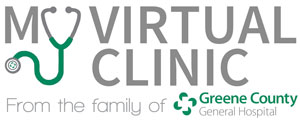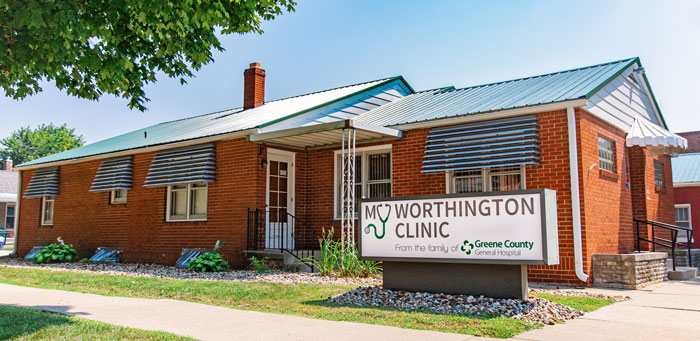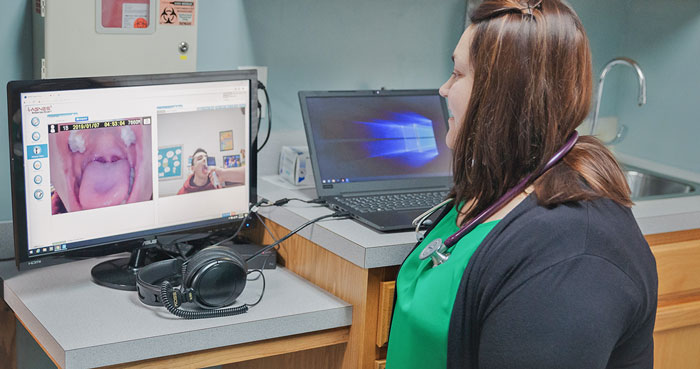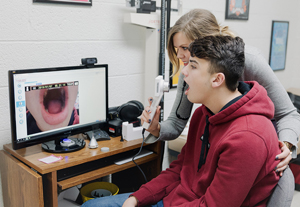My Virtual Clinic School-Based Telehealth Program
- Need: Improve healthcare access for school-aged children in a rural and underserved Indiana county.
- Intervention: Working with several rural school districts and the state's rural health association, an Indiana county healthcare system used school-based telehealth to expand access for acute illness.
- Results: As of May 2019, Greene County General Hospital in rural Linton, Indiana, has expanded primary care access by offering school-based telehealth in 2 elementary and 1 middle school in 3 of the county's 5 school districts.
Description
Several Greene County, Indiana, statistics contribute to the area's health disparities, for example, its primary care Health Professional Shortage Area designation and its poverty indicators. According to the County Health Rankings & Roadmaps using 2016 data, Greene County had 1 primary care provider (PCP) for every 3,500 people — compared to the state's average of 1 PCP for 1,500 people and the country's "best average" of 1 to approximately 1,000 people. According to 2019 Census data estimates, nearly 11% of the county's population lives in poverty.
To address the health impact of these issues on rural school children, three local organizations joined forces to expand access by offering telehealth: the Greene County General Hospital (GCGH), the White River Valley School District (WRVSD), and the Indiana Rural Health Association (IRHA), an organization leading previous successful efforts increasing the state's rural broadband and telehealth infrastructure.
The IRHA leveraged federal funding to create the Indiana Rural Schools Clinic Network (IRSCN). In its role as a convenor with a prime focus in expanding healthcare access by using school-based-telehealth, the organization collaborates with both schools and healthcare organizations. When WRVSD school leaders became interested in the telehealth offering, Greene County General Hospital (GCGH), a Critical Access Hospital (CAH) in Linton, Indiana, was invited to serve as the clinical partner.
 The
collaboration fit GCGH's mission to provide the area's
residents with both inpatient and outpatient care. To
help clarify the new school-based telehealth service, a
separate division was created, My Virtual Clinic. The
network members are four separate GCGH Rural Health
Clinic sites, with a total provider complement of 8 nurse
practitioners and 3 family medicine physicians.
The
collaboration fit GCGH's mission to provide the area's
residents with both inpatient and outpatient care. To
help clarify the new school-based telehealth service, a
separate division was created, My Virtual Clinic. The
network members are four separate GCGH Rural Health
Clinic sites, with a total provider complement of 8 nurse
practitioners and 3 family medicine physicians.
The school-based effort also depends on another key health provider: the school nurse. School nurses in this setting are under the supervision of GCGH's executive director of nursing.
Prior to the go-live service, information technology (IT) needs were addressed. Both the school and the health system IT teams reviewed broadband capability and HIPAA-compliant platforms. In addition to examining the electronic pathways of the actual telehealth visit, the electronic medical record's interoperability was modified in order to accommodate availability to clinicians, but independence from the academic record. The students' medical records are not accessible by school personnel.
In advance of the program's implementation, the three organizations provided public awareness campaigns for parents/guardians and the general community. Teachers were briefed on telehealth visit workflow. Printed information was provided to parents. School administration responsibilities were to collect parental authorization forms for those interested in virtual visits, along with insurance information.
Care is payer-agnostic: All students will receive any needed care regardless of ability to pay. GCGH bills insurance payers or provides a sliding scale payment option. If the student is uninsured, another program benefit is offered: Referral to the area's insurance navigators providing enrollment assistance. This workflow was designed because almost half of the county's nearly 5,400 school-aged children enrolled in public schools received free and reduced-fee lunches, often an eligibility indicator for Indiana Medicaid or Indiana's Healthy Indiana Plan.
IRSCN provided the telehealth equipment and software packages for both the schools and the clinics. It also provided staff training and support during the planning, development, and implementation stages.

IRHA received grant-funding for IRSCN's development through the Network Grant Program provided by the Federal Office of Rural Health Policy's Office for the Advancement of Telehealth.
By May 2019, the program had been implemented in 2 elementary and 1 middle school in 3 of the county's 5 school districts. Three additional schools were added in the 2019-2020 school year with those new sites nearing full functionality by January 2020. However, all appointments stopped in March 2020 when schools closed due to COVID-19. Telehealth equipment was then moved from the schools to GCGH's hospital and clinic sites. When schools re-open, the telehealth equipment will be returned.
As a recent grantee of the Federal Communications Commission's Wireline Competition Bureau's COVID-19 telehealth program, GCGH be purchasing additional telehealth equipment to meet future school-based and other local telehealth needs.
Services offered
The program's staffing needs include:
School-based staff:
- On-site school nurse, supervised by GCGH's executive director of nursing
- School personnel assigned to permission/insurance data logs
- School personnel available as needed to assist the school nurse
Clinical staff:
- 4 My Virtual Clinic Rural Health Clinic sites, 8 nurse practitioners, 3 family medicine providers
Clinical visit elements:
Timely acute illness evaluation and treatment occurs when
the school nurse determines a condition warrants provider
evaluation. Following a triage process similar to that in
the providers' clinic, parental permission is confirmed,
health information updated, and relevant history, vital
signs — and, if needed, images and school-based lab tests
related to the chief complaint — are made available for
provider review. The telehealth software system sends an
alert to the clinics' system and the next available
provider sees the student. The evaluation further depends
on either the school nurse or other trained school
personnel to use the telehealth system's stethoscope,
otoscope, or dermascope for skin exams, functioning as
the remote provider's eyes, ears, and hands.
Because common student illnesses often require simple laboratory studies, GCGH is able to offer limited school-based laboratory testing for strep throat, influenza, and urine problems, tests that are also performed by the school nurse.

Results
Project results include improved access made possible by school-based telehealth: less illness-related absences, timely provision of troublesome symptom relief, and prevention of disease progression to a more serious stage.
Another benefit from early and accurate diagnosis of acute illness can be the result of decreasing the spread of communicable disease, a goal the Indiana State Department of Health takes as its responsibility, but notes that "public health officials rely upon the cooperation and contribution of schools, health care providers, and parents to prevent the spread of disease."
Additional results are due to the strong relationships built as a result of this school-based telehealth program. For example, GCGH is now involved with other school-based health-related activities: emergency planning, preventable injury work, and student athlete care.
 GCGH
administration also noted one unanticipated benefit:
their employees' satisfaction. Since employees' children
are in the schools served by My Virtual Clinics,
employees appreciate the overall benefits that come with
increased and timely access to medical care for the
community's children.
GCGH
administration also noted one unanticipated benefit:
their employees' satisfaction. Since employees' children
are in the schools served by My Virtual Clinics,
employees appreciate the overall benefits that come with
increased and timely access to medical care for the
community's children.
After implementation in the first several schools, nearly 75 visits occurred.
Note: By flexing equipment and building on the existing telehealth strengths that are in part related to GCGH's school-based telehealth efforts, as of mid-May 2020, the health facility had delivered over 800 primary care, long-term care, and surgery telehealth appointments in order to address their population's medical needs during the area's COVID-19 surge.
Challenges
- Challenges with interoperability of electronic information exchange.
- Unanticipated internet outages, but none to date have impacted virtual visits.
Replication
- Form strong partnerships with local schools.
- Anticipate positive responses from the local community, parents, and teachers.
- Provide an environment and platform for team members to learn best practices and discuss solutions for unanticipated challenges.
Contact Information
Stacy Burris, Marketing DirectorGreene County General Hospital
812.847.5223
Stacy.Burris@mygcgh.org
Topics
Access
Children and youth
Outpatient care
Rural Health Clinics
Schools
Telehealth
States served
Indiana
Date added
May 20, 2019
Date updated or reviewed
May 22, 2020
Suggested citation: Rural Health Information Hub, 2020. My Virtual Clinic School-Based Telehealth Program [online]. Rural Health Information Hub. Available at: https://www.ruralhealthinfo.org/project-examples/1059 [Accessed 19 April 2024]
Please contact the models and innovations contact directly for the most complete and current information about this program. Summaries of models and innovations are provided by RHIhub for your convenience. The programs described are not endorsed by RHIhub or by the Federal Office of Rural Health Policy. Each rural community should consider whether a particular project or approach is a good match for their community’s needs and capacity. While it is sometimes possible to adapt program components to match your resources, keep in mind that changes to the program design may impact results.
